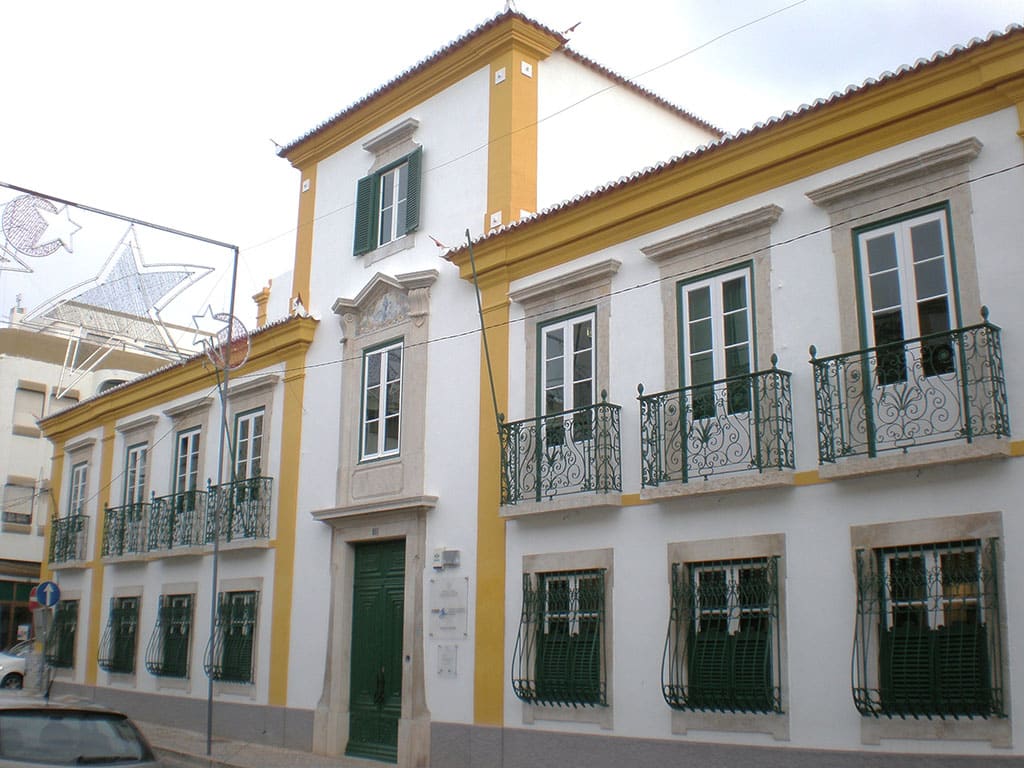High on the hill which dominates the east of the city of Faro stands the Ermida de Santo António do Alto, a 15th century chapel. To the west, it overlooks the districts of Garganta and Rio Seco and the main EN 125 towards Olhão.
To the south lies the railway station of Bom João and the district known as Atalaia, which translates as watchtower. The chapel of Santo António incorporates a tall tower, constructed in 1355, which for 500 years served as a look-out post for guards to give warning of attacks on the city by the Barbary corsairs.
Colégio de Nossa Senhora do Alto
Immediately opposite the chapel is the imposing entrance to the Colégio de Nossa Senhora do Alto. A little further down the hill to the east, and also overlooking the approaches from Olhão, the Palácio do Alto now serves as part of the school.
Visible from some distance, this early 20th century building was once the proud domestic establishment of perhaps the richest Algarvian, João António Júdice Fialho, and when it was built, it was surrounded on all sides by farmland.
The Palace – our visit
During our visit on a rainy Thursday, we learned something of the history of this remarkable and unique building.
We parked in the rain and encountered Rui (a friend who teaches at the Colégio de Nossa Senhora do Alto) as we completed a round of this square and symmetrical building.
He led us down to the basement level to the almost hidden present-day entrance which is the only entrance in everyday use.
The basement of the building consists of kitchens (complete with the original still functioning dumbwaiter) occupied by chefs preparing lunch for the school staff. We passed well stocked pantries and storerooms, observed the massive door of the original safe, and came to the huge laundry-room, now containing modern washing machines to go with the original sinks.
In one corner is a massive box cupboard, an elderly airing cupboard was how the servants kept dry and warm the clothes of the first owners. In the north-west corner of the building, we saw the original lift displaying the manufacturer’s name OTIS. It is perhaps the oldest working lift in the country.
Ascending to the ground floor, we found the teachers’ dining room, the library and music room, currently used for teaching the piano, and, attached to the wall, a very old telephone, said to be the first telephone in the Algarve.
Up the massive entrance staircase to the piano nobile, we found the chapel. This was as far as we went, because many of the rooms on this floor and the one above are still inhabited. These inhabitants are sisters and priests, since the Palace is owned by the church, and is part of a Catholic school.
The beautiful floors are of polished wood, sometimes covered in carpet which was apparently original – a hundred years old. Rui explained that the house had originally owned a number of neighbouring farms, and the school had benefitted from their produce, proof, if it were needed, of Fialho’s wide agricultural ownership, and his plans to support the house with locally produced food.
The grounds
In the grounds, beyond the stone terraces in front of the house, lies the abandoned mason’s yard, dotted with blocks of unused stone, and planted with trees of some age. It was strange to see such abandonment and disorder close to so perfect an example of domestic architecture.
To one side of the house, in one of the formal gardens, stands a stone structure which may have been a font. It is carved and decorated and appears to be of the Manueline (16th century) era.
Fialho commissioned this huge house in 1913 during the heyday of his business empire. The architect was Manuel Joaquim Norte Júnior (1878-1962), and his design is heavily influenced by 19th century French classical architecture. It was built over 10 years (1915-1925) and must have been at that time the most luxurious residence in the Algarve.
Such an establishment must have relied on large numbers of staff and servants, and this expensive lifestyle was supported by Fialho’s extensive and profitable businesses. Impressive though the building is, it is clearly expressive of the luxury of a bygone age and our modern ideas of luxurious living are quite different.
Family
In 1882, João António married the elder daughter of Dr Justino Cúmano. They had two children, both daughters. It was through this connection that Fialho became the owner of yet another property in Faro, the Palacete Doglioni, or Palácio Cúmano, which he must have inherited from his father-in-law. It was the Cúmanos who had renovated this handsome 17th century house, as well as the Teatro Lethes in the centre of Faro.
Fialho was always a hands-on manager and, until the day he died, he was in control of all parts of his business empire. He micro-managed the canning business (corresponding with his agents abroad, managing the buying and selling of fish, the timely importation of raw goods, the export of canned products, the analysis of quality) as well as the overall control of his agricultural businesses.
Art collection
Fialho was also a man of culture – he collected books, tapestries, china and paintings, and added the collection he inherited from his father-in-law Justino Cúmano. His art collection is reputed to have been both extensive and fine. Sadly, none now remains in the house, although there are one or two statuettes which were overlooked when the collection was dispersed.
The decline
It may be that the reason for the sale of the house was the decline in the business fortunes of the Fialho empire after he died – perhaps there was no-one with the skill to manage such a large and disparate business in challenging times – and the Fialho businesses were all sold in 1981.
It is not clear when the family sold the house and surrounding farmland (either in 1945 or 1960), but the purchaser was the Diocese of the Algarve, and the Palace is in constant use as part of the catholic Colégio de Nossa Senhora do Alto. João António Júdice Fialho would be very happy that his Palace is still in use, and in such good repair.
By Peter Booker
|| features@portugalresident.com
Peter Booker co-founded with his wife Lynne the Algarve History Association.
www.algarvehistoryassociation.com




















